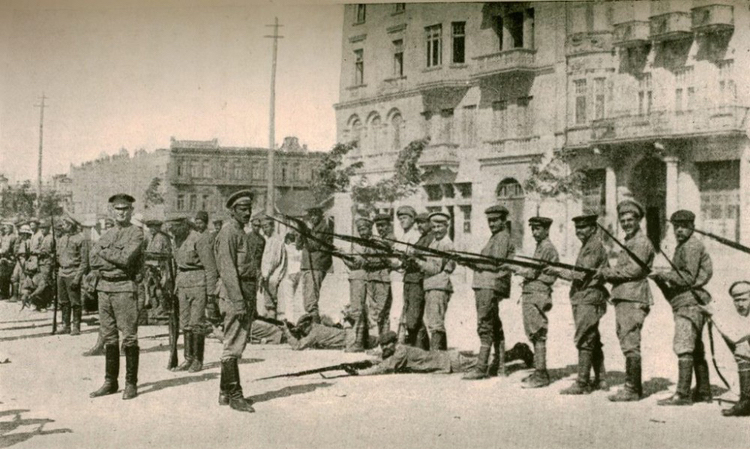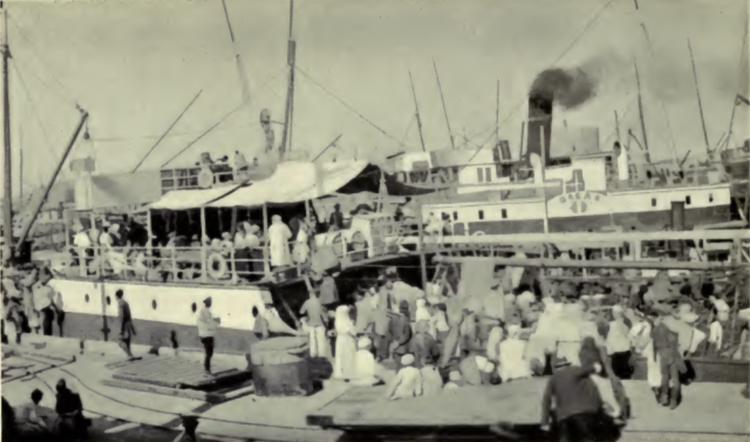The period of the Baku Council of People’s Commissars

After the February revolution in Russia in 1917, dual governance was implemented in Baku. The local body of the interim government was the Executive Committees of Public Organizations and commissars elected by them. On March 7, the election was held to Baku worker deputies’ committee. On March 29, Baku Muslim Council (M.A.Resulzade, M.Hajinski, A.Topchubashov, F.Khoyski, M.Asadullayev and others) was organized.
After the Bolsheviks seized power in Petrograd (October, 1917), on October 31 (according to a new calender on November 13), a resolution on transfering the power to Bolshekivs was adopted at a meeting of the Baku Council. On November 2 (15), the Baku Council Executive Committee became the supreme governing body. The abolition of the Public Organizations Executive Committees was realized. On November 29, the elections were held to the Constituent Assembly in Baku. Musavat Party has gained an absolute advantage in the election. A new election took place to the Baku Council on December 12-16. There were 51 Bolsheviks, 38 left-Esers, 41 Dashnaks, 28 right-Esers, 21 Musavatists and 11 Mensheviks from 190 deputies. On January 18, 1918, A.Chaparidze was elected chairman of the Baku Council Executive Committee. The Soviet Russia, firstly V.I.lenin, carried out seized power policy in the whole Azerbaijan through the Baku Council. For this reason, the Council of the People’s Commissars of Russia adopted a resolution on sending 500 thousand rubles to the Baku Council. S. Shaumian was appointed as Extraordinary Commissioner to lead Caucasus Affairs. The Baku Council under the leadership of S.Shaumyan carried out some socialist steps and created Soviet military units consisting of Armenian-Dashnak coalition.

The slaughters of the Turkic population in March 1918, launched by Dashnak Armenian gangs under the guidance of Stepan Shaumian, altered the political situation in Baku in the favor of Bolsheviks. Most of the Azerbaijani families had to leave the city; many of them fled to Central Asia and Persia, and the rest scattered in the surrounding villages to escape genocide by the Bolshevik-Dashnak gangs. Patronized by high-ranking Armenian “Bolsheviks,” the Dashnaktsutiun leaders acted as sole owners of Baku. All papers and magazines but Armenian-Bolshevik political organs were shut down. Bolsheviks gained control of the entire transport and established a labor commissariat and food directorate. Notwithstanding the ban on all national councils, the Armenian National Council continued functioning. On April 25, Bolsheviks established the Baku Council of People’s Commissars to assume the entire authority over the city.
S.Shaumian was elected chairman of the Baku Council of People’s Commissars. He was a Commissar for Foreign Affairs at the same time. The Baku Council of People’s Commissars consisted of staunch nationalist Armenians and Russian Bolsheviks cooperated closely with them. Azerbaijani commissars were mainly “entrusted” economical areas. Nariman Narimanov was appointed People’s Commissar for the Municipal Economy, and Mir Hasan Vazirov was People’s Commissar for the Land Affirs. So, representatives of local Azerbaijani population weren’t allowed to have any high position in the government. An attitude of brutal hostility was maintained against the Muslim population after the March massacre as before . S.Shaumian, under the veil of establishment of “workers’ and peasants’ authority,” set a goal to cleanse Azerbaijan of Azerbaijanis, plunder the resources of the country, and realize the dream of Great Armenia on the Azerbaijani lands. He also directed the activity of the Baku Council of People’s Commissars for this purpose. Under Moscow’s direct command, the Baku Council of People’s Commissars nationalized the oil industry and arranged the delivery of oil to Russia. In order to speed up the production and transportation of the Azerbaijani oil, Lenin approved allocation of one hundred million rubles to the Baku Council of People’s Commissars. In comparison with the period between November 1917 and March 1918, when only 4,313,000 puds of oil were delivered to Russian ports, this number reached 80,025,000 puds from early April to late July 1918. Over 700,000 puds of cotton, 100,000 puds of dried fish, tons of rice, salt, and other provisions were supplied to Russia from Baku and Azerbaijani provinces under the guise of fraternal aid.

The Baku Council dismissed the City Duma of Baku chaired by Fatali khan Khoyski and declared the Transcaucasian Seim a counterrevolutionary entity. The Moscow leadership applied best efforts to bolster the Baku Council of People’s Commissars both in military and political terms. At Lenin’s direction, the Military Commissariat and the Council for Revolutionary Struggle arranged swift supply of all necessary ammunition for the Soviet troops in Baku and sent five thousand rifles, two million cartridges, thirty-five machine guns, four armored vehicles, and thirteen aircrafts. The process of Armenianization of the Baku Council of People’s Commissars’ army in Baku has been completed. Grigory Korganov, then navy commissar of the Baku Council, writes in a letter to Moscow: “The commune army numbers 18,000 troops; the overall majority of soldiers, roughly 13,000, and almost all officers are Armenians.”
Moscow was fully satisfied with the national composition and the national hostility and intolerance policy against local Azerbaijanis carrying out by the Baku Council of People’s Commissars. Moscow viewed oil Baku as influence mechanism over the anti-Azerbaijani regime to keep the South Caucasus under its sway.

Menshevik, Eser, Dashnak and
English civilians leave Baku.1918
One of the main tasks of the Baku Council of People’s Commissars was to attack Ganja and overthrow the Democratic Republic of Azerbaijan. However, the four-day intense conflict between June 27 and July 1 determined the destiny of the front. In this battle, the Caucasian Islamic Army consisting of people’s volunteers and Azerbaijani and Turkish military units disrupted the Baku Council of People’s Commissars’ troops and moved towards Baku. Soon, the Baku Council of People’s Commissars left the scene of history as an alien institute to the Azerrbaijani atmosphere.
The government of Sentrokaspi arrested the Baku Council’s leaders, who seized the power in Baku in a cruel way “for embezzlement of ownership”. On September 15, when the Caucasus Islamic Army liberated Baku, the leadership of the Baku Council boated from Baku. On September 20, the leaders of the Baku Council arrested by Esers, except Stepan Shaumian, were shot dead in Agjakum valley near Krasnavodsk (now Turkmenbashi city).
In the center of Baku , in “Sahil Park” a memorial monument was erected to the commissars shot in the Agjakum valley during the Soviet period. After Azerbaijan regained its independence, the activity of the Baku Council of People’s Commissars was objectively assessed. The memorial monument was demolished.
